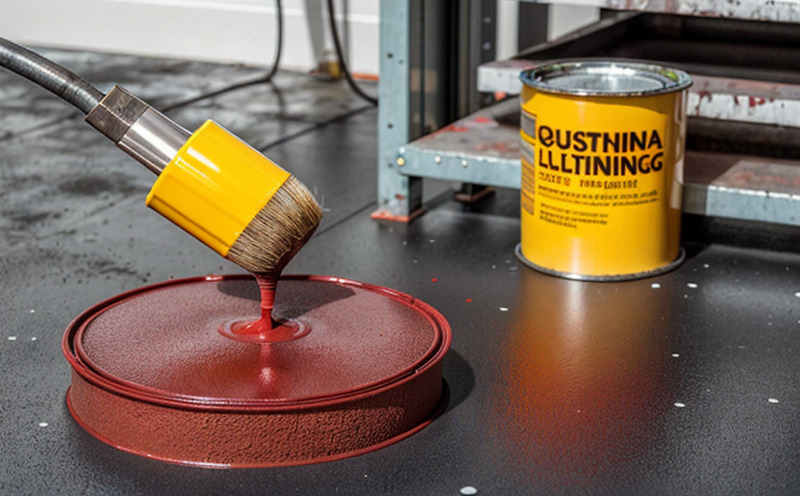JIS K5601 Chemical Resistance Testing of Paints
The JIS K5601 test method is a critical standard used to evaluate the chemical resistance of paints. This standardized procedure ensures that manufacturers can accurately assess how well their coatings withstand exposure to various chemicals, which is essential for industrial applications where durability and safety are paramount.
The JIS K5601 test involves exposing paint samples to different chemical agents under controlled conditions over a specified period. The specimens are then evaluated for any changes in color, appearance, or adhesion that could indicate degradation due to the chemicals' influence. Compliance with this standard is necessary for products intended for use in industries such as automotive manufacturing, aerospace, and construction.
The test can be conducted using multiple chemical agents depending on specific application requirements. Commonly used solvents include hydrochloric acid (HCl), sulfuric acid (H2SO4), and sodium hydroxide (NaOH). The choice of solvent reflects the expected environmental conditions or intended use of the paint. For instance, paints destined for outdoor applications may be tested against more aggressive chemicals like saltwater spray or UV exposure.
The methodology specifies precise guidelines on sample preparation, contact time with the chemical agent, temperature control during testing, and evaluation criteria post-test. The primary goal is to provide consistent results that reflect real-world performance without over-exposing specimens beyond their expected service life.
| Parameter | Description |
|---|---|
| Test Chemicals | Hydrochloric acid, sulfuric acid, sodium hydroxide among others. |
| Contact Time | 24 hours or as specified by the test method. |
| Temperature Control | Maintained within a range of 30°C ± 1°C during testing. |
| Evaluation Criteria | Changes in color, gloss, adhesion, and appearance are assessed post-test. |
The importance of JIS K5601 chemical resistance testing cannot be overstated. It provides a clear benchmark for manufacturers to ensure their products meet quality standards required by the industry. By adhering to this standard, companies can enhance customer trust and market competitiveness while maintaining regulatory compliance.
For industries like automotive manufacturing, where vehicle finishes must withstand harsh environmental conditions and rigorous cleaning procedures, JIS K5601 testing is crucial. Similarly, in aerospace applications, where paint integrity directly impacts safety and reliability, this test ensures that coatings perform reliably under extreme conditions.
Why It Matters
The results of JIS K5601 chemical resistance testing are significant for several reasons:
It helps manufacturers identify potential weaknesses in their paints before they reach the market, thus reducing the risk of product failure.
Ensures compliance with international quality standards, which is essential for export markets and global supply chains.
Provides data that can be used to improve formulations and enhance durability through continuous improvement cycles.
The test also plays a vital role in ensuring safety by preventing the use of paints that might deteriorate under operational conditions, leading to potential hazards. For instance, in construction or manufacturing environments where exposed surfaces come into contact with corrosive substances, reliable paint coatings are crucial for maintaining structural integrity and worker safety.
Scope and Methodology
The scope of JIS K5601 includes the evaluation of the chemical resistance properties of paints. This involves determining how well a given coating resists damage from contact with various chemicals over time. The method specifies detailed procedures for preparing test samples, conducting exposure tests using specific solvents, and assessing outcomes based on predefined criteria.
| Step | Description |
|---|---|
| Sample Preparation | Cut paint specimens to standard dimensions and apply them uniformly onto a substrate. |
| Contact with Chemical | |
| Evaluation | Inspect and measure changes in color, gloss, adhesion, and overall appearance after exposure. |
The methodology ensures that all tests are conducted under consistent conditions to produce reliable results. This standardization is crucial for comparing data across different manufacturers and ensuring that the paints meet industry expectations regarding performance and longevity.
Use Cases and Application Examples
Aerospace: Ensures that aircraft coatings can withstand exposure to fuels, lubricants, and cleaning agents without degradation.
Construction: Evaluates the durability of building materials, such as concrete or steel, where paints are used to protect against environmental factors like saltwater spray.
Automotive Manufacturing: Guarantees that vehicle finishes remain intact despite frequent washing with detergents and exposure to road salt.
In addition to these industries, JIS K5601 testing is applicable in any scenario where a paint coating needs to demonstrate resistance against chemical agents. This includes specialized applications like chemical plant equipment or medical devices requiring non-reactive finishes.
Medical Devices: Ensures that the finish does not leach harmful substances into contact areas, maintaining patient safety.
Chemical Plant Equipment: Guarantees that coatings do not react with chemicals being processed, preserving equipment integrity and preventing contamination issues.
The versatility of JIS K5601 testing allows for a wide range of applications across various sectors, making it an indispensable tool in ensuring product reliability and safety.





